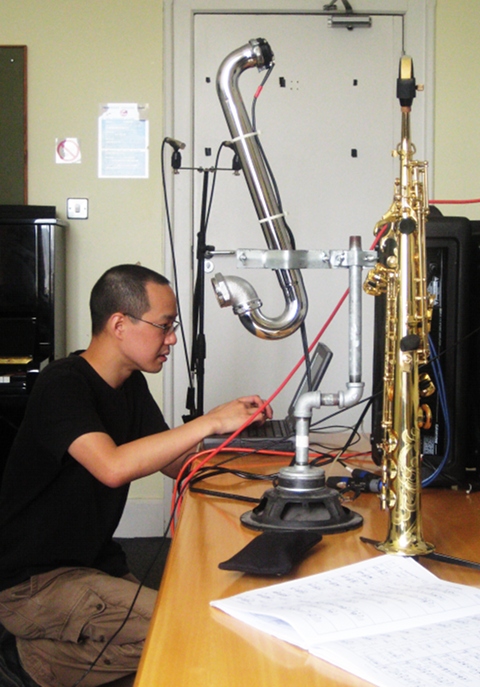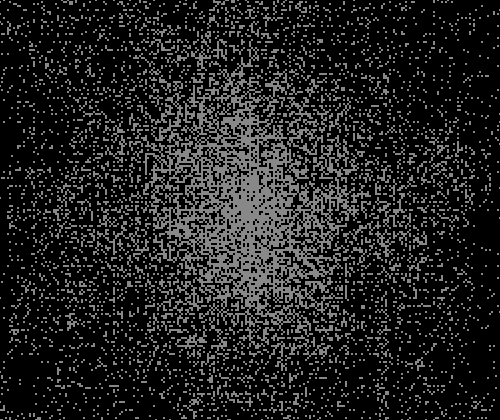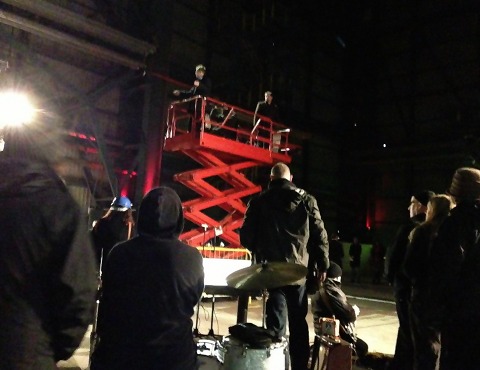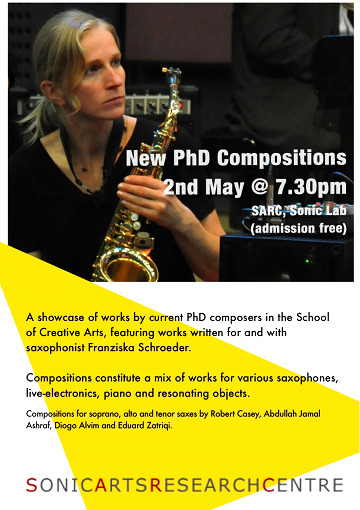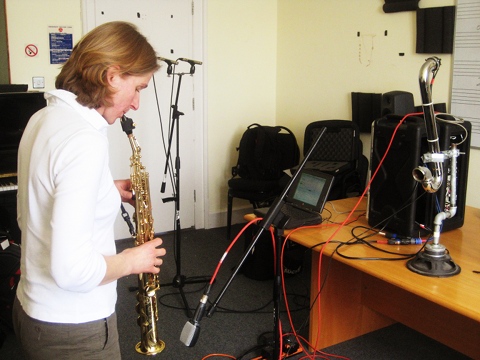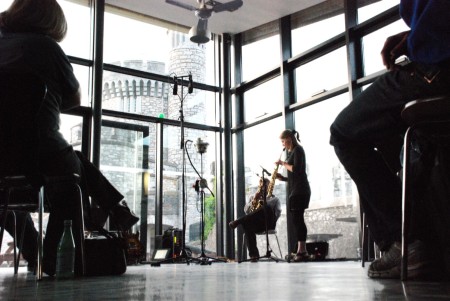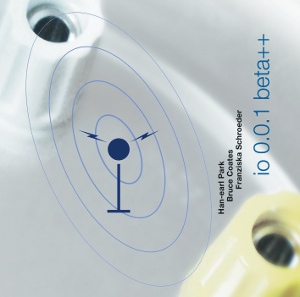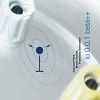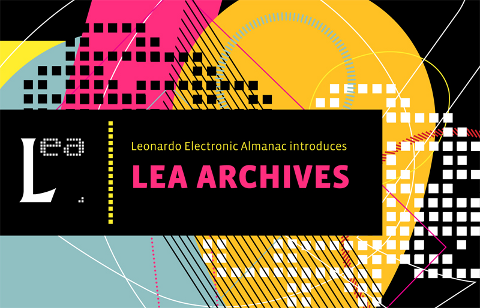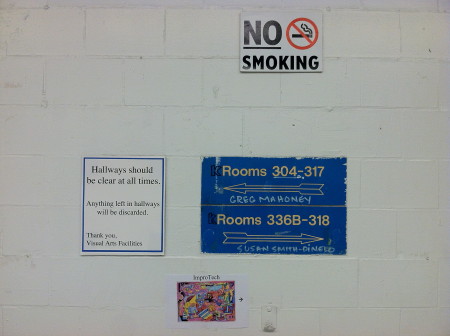
As a institutionally unaffiliated, part-time geek (and amateur anthropologist), I find the Computer Music tribes’ behavior fascinating. This is an unedited transcript of my observations from ImproTech Paris-New York 2012 : Improvisation & Technology series of events. My original observations came in the form of live tweets via @hanearlpark that spanned the performances on May 16, 2012 at the Roulette, and the ‘workshops’ (which I would describe as paper presentations or demonstrations) over the following two days at NYU and Columbia (the closing concert at Columbia gets a very short mention at the end).
I am writing a more humanly readable summary/expansion on some of these issues. I hope to have that article posted in the next few weeks, but in the meantime, for an alternative, complementary, critical take on the concert, see Melanie L. Marshall’s article on the ImproTech concert. I am indebted to @drmelmarshall, @tperkis, @piesaac, @jeffalbert and @weefuzzy for their twitterverse interactions that shaped my responses.
Twitter transcript (unedited)
Concert: Brooklyn, May 2012
Some thoughts from a technomusical concert coming up…
1. remind me to tell you about Joel Ryan’s story about politicking in computer music
2. wow. it’s like what turntableists did like three decades ago. #culturalborders
3. it’s the third time in two months I think, if you take away the electronics, there’s really fine ensemble there
4. funny how the iconoclasm and high mindedness is expressed by the uniformity of brand logos
5. almost feels more like a product demonstration than a concert performance #cantputmyfingeronit
6. Wasn’t this was more absurd/playful/questioning when Kagel did it?
7. How does one develops virtuosity w/ a trackpad/qwerty/lcd combo? Is virtuosity an impossibility?
8. Is it possible to develop a musical practice w/out a common practice notion of instramentalism?
9. What are the power implications of the sweaty saxophonist vs the effortless laptop?
10. Why is this more worthy of my attention in comparison to a NAMM show performance?
11. What would we do without cycles of fifth?
12. That really was terrible.
13. How often have you heard live electronic performance where you didn’t perceive the electronics as (primarily) reactive? #notacriticism
14. Why the ubiquity of the ramp envelope (the swell) in electronics? Are we fearful of sudden hits and cut outs?
15. …or does it perform the western romantic notion of the orchestra, with the centrality of the bowed strings?
16. While trip-hop and glitchcore explore the frayed edges of the artificial, why is so much Computer Music stuck w/ this?
17. …does the ‘natural’ (or the fear of the artificial) haunt the CM enterprise?
18. reminded of Park’s First Law of Live Electronics 😉
19. is, say, a cello (always) already designed w/ the possibility of virtuosity? What does that mean for trackpads/qwerty/footswitches?
20. I am reminded of Richard’s talk about the need to spend time practicing—forging a kind of virtuosity and familiarity.
21. Anyone else feeling overfamiliar w/ the vocabulary of live video processing (in high art)?
22. …what is video processing? Is it a reductive, sculptural medium? Is it painterly?
23. …Is the emphasis on transformation, invention, or the magnification of what is already in the image?
24. Why don’t we hear the juxtaposition of the unamplified and the electronic more often? Again, is it the fear of the artificial?
25. Ask @tomerbe to tell you a story about GEL et al. and Bob Moog at ICMC 😉
26. apologies for the lack of tweets, but that last performance was… fantastic. I could listen to RM all night.
27. The problem w/ percussion in European concert music is that you can _hear_ the (limits of its) notation (abstraction/schema).
28. this sounds like the CM we did when I was at the conservatory almost 15 years ago. Why the relative stasis in practice/sound?
29. …it would be wrong for me to repeat Bob Ostertag’s question… so I won’t 😉
30. Reminded of Zappa’s rhetorical question of why anyone would want to see someon on stage press the PLAY button.
31. …also reminded of the old joke about the rock band that discovers their hit song by observing that it’s sh*t but at least it’s different
32. what is the effect when such simplistic notions of interaction are presented w/in the context of a shiny futuristic technotopia?
33. Problematic: I think this is great, and then realize that I have, as a listener, phased out the electronics.
34. In an improvisation, if a player is doing something systematic, detailed, & compelling, are you not obliged to meet them in that space?
35. Not convinced. Didn’t Ikue do this in the 90s w/ far more sophistication and humor?
36. Problematic musically, but I’m fascinated by this piece from an engineering standpoint. #theConstructorIsIn
37. Final thoughts: I only walk out of two performances, & I didn’t make my CM concert face, so that’s a lot better than most.
38. I always take my hat off to GEL. His post-Voyager pieces almost make me listen & forget my engineer’s hat.
38. See @drmelmarshall’s observations about gender. There’s a strong (perhaps self-defining) gender/race/class dynamic of CM.
39. …the dynamic is so strong that perhaps the only way you can continue to practice Computer Music is by ignoring the ideological…
40. …or perhaps the only people who continue practicing CM are those who are unaware of the ideological implications…
40. …or, more worrying, subscribe to certain gender/class/race ideologies.
41. …computers in so much CM the computer becomes assistive technology for the composer; further centralizing autocratic power…
42. …and power of definition.
addendum to tweet 29: Ostertag’s question. http://bobostertag.com/writings-articles-computer-music-sucks.htm #computermusic #politics #technology
43. following for a conversation w/ @drmelmarshall: is the anti-performance, anti-virtuosity stance of CM laptopiteers because…
44. …they identify as composer w/in the composer-performer hierarchy? To ‘perform’ in this context would be to identify w/ lower caste.
45. …studied anti-virtuosity similar to the ‘all mind’ of certain class of (white, male, bourgeois) academics as described by bell hooks.
Conference: New York, May 2012
Random thoughts from a technomusical conference coming up…
1. GEL: “creative machines” #expressiontoremember
2. GEL: improvisation ~ “process of social transformation”
3. I want to know more about imbuing machines w/ “integral subjectivity”. Let you know when I get a chance to corner GEL.
4. Never realized how much Richard’s playing resembles Sun Ra’s. #makingconnextions #aha
5. is this relational schema correct? tech knowledgepractical usemusical knowledge #epistemology #technoscience #music #culture
6. …do not (musical) technical objects (always) already (materially) embody musical knowledge?
7. …is not musical knowledge (always) already performed by the technical (in its construction, etc.)?
8. Is knowledge something that can be bound? Is it useful to think of (technical) knowledge in terms of intention?
9. …practice of close-reading & reverse-engineering suggests the link between intention and knowledge is a distraction, or fuzzy at best.
10. why the distrust of the regular beat?
11. Polish notation! #geeklove
12. reminds me of the ‘Free Jazz Bass Player’ simulator that I hacked in an afternoon. #isComputerMusicBeyondParody
13. Can musical be reduced to a series of BANGs. It’s not even a data type. #Max
14. Before asking the question of whether machines can improvise, should we ask if we can determine if we ourselves can improvise?
15. machine agency live on stage during a conference about machine agency. #revoltoftechnics
16. Is it useful to study #improvisation by drawing boundaries around it? thru definition? #ontology
17. …or would it be more illuminating to study #improvisation by its effects?
18. Ah, John Searle’s critique of hard AI. @weefuzzy will get this.
19. Is an algorithm an abstraction or representation of what a computer does, rather than (necessarily) what it _actually_ might be doing?
20. But Searle’s objection was partly a critique of lazy sizeism; there is no reason to believe that complexity/scale leads to intelligence?
21. Does no one else understand Searle’s critique?
22. Is the Western #Subject (as theorized/critiqued by #Foucault) holding us back in understanding the improvisative? #subjectivity
23. … #improvisation may offer alternative notions of #freedom, or relations, say, that have radical implications for the subject.
24. Searle’s critique actually nullifies the second stance: improvisation as an emergent property of a complex of algorithms. #duh
25. Do you ever see a paper title and wonder if they will address the ‘why we did this #research’ question? #academia #music
26. Apropos of nothing, the last transcription I did was Taylor’s Jitney… cured me of the need to do more perhaps.
27. Ever imagine if your, say, bugle or snare drum would be playable if it had even 1/10 of the latency of digital devices?
28. If gestures are the focal point of interaction/creation, why does one have to link it to novel sounds? #unaskedquestion
29. Pointless. #goingoutforair
30. 1 more thing: Searle’s critique was specifically of Hard AI’s dependence on simple, deterministic algorithms…
31. …it does not necessarily follow that it applies to other forms of computing (embodied robotics, neural networks, analog computation).
32. why the prefix ‘augmented’? what distinguishes it from, say, ‘cyber’? #nomenclature #artscatchphrases
33. Is #improvisation a tool? or is it a practice? process? method?
34. old question: is the notion of #mistake, flaw, right/wrong useful in discussing #improvisation?
35. Computer Music loves is acronyms & initialisms. #tradition #nomenclature #linguisticdetritus
36. …which I parodied w/ AMM™ (Automatic Morricone Machine-temporal morphologies) & io 0.0.1 bets++ (not an acronym). #linguisticdetritus
37. Interesting: first instance of a presentation dealing (pragmatically) w/ the issue of machine latency. #time #computation
38. …something that Bruce, @franzschroeder & I spent a lot of time, effort & (I hope) ingenuity addressing w/ io 0.0.1 beta++. #latency
39. Reminded of Risset’s advice about the importance of a Panic Button. #computermusic #liveelectronics
40. Why is on-screen feedback so important for these new #instruments? We don’t need flashing lights on the fingerboard. #interface
41. …despite our training, can we not trust our ears & bodies w/ these technologies? #instrument #technology #interface
42. …or is this an instance in which system #latency prevents reliable aural or tactile #feedback? #instrument #technique
43. Ask Joel Ryan to give you the incredibly detailed, rigorous meditation of The Slider.
44. Much of this is the realization of things we were klugily _attempting_ w/ archaic technology (8bit microcontrollers, MIDI) 10 yr ago…
45. …& would we have continued down that path had we known the results as they are realized now? #whatwasourmotivation #technodreams
46. Why are our technodreams just that little bit out of reach? Why are systems just one ‘feature’ short of what we desire?
47. …generally guitarists, say, do not wish if only the guitar frets spacing were wider in the middle register it would be perfect.
48. … #virtuosity becomes a #negotiation between the #technical, #physical & #physiological, not wishing extra limbs or laws of physics.
49. fascinating. people talk about Max (not the ‘program’, or ‘computer’) as the name of an entity. #linguisticdetritus #technics
50. Structured programming is not possible with Max. #discuss
51. In the middle of all this technomusical talk/presentation, get a real desire to hear @uitti2bows play. #realmusicianship
52. old joke: mathematicians’ results r precise, but study toy problems. engineers study real-world problems, but their results r approx…
53. …computer musicians, being neither engineer nor mathematician, study toy problems & fudge their results 😉
54. yrs ago, Murray Campbell & I had a plan 2 present an entirely fabricated, counterfeit project, SimJazz: the desktop bebop simulator.
55. …some of that survives in the blurb at //www.busterandfriends.com/amm/ …anyway, maybe it’s time to revive that. #beyondparody
56. I live by my volume pedal, and I’d like to say that foot pedals definitely are _not_ and easy option. #feelstronglyaboutthis
57. interactive systems w/in a compositional frame? feels like @DoctorNerve or Clarence Barlow should be referenced in this presentation.
58. said this before: clamshell of laptop is designed to closeout the rest of the world. fine as your mobile office, but not as performance…
59. …Nic Collins said it’s like playing battleships. #laptop #music #performance #narcissism
60. borrow an expression from @matanaroberts: robotrane 😉
61. anyone remember Matt Ingalls’ work with improvising automata? #youshoudlookthisupifyoudontknowit
62. fwiw, here’re my (old) experiments w/ generating #rhythm: //www.busterandfriends.com/hz/ #musicaltime #algorithm #robotics #automata
63. wonder if (notational) abstractions (quarter notes, triplets etc) are useful algorithmically. Perhaps there r computational shortcuts.
64. …perhaps we don’t generate rhythm w/ that notational abstraction. Maybe that abstraction is after the fact.
65. 1st presentation in which the entity is called ‘computer’ not Max? (‘computer’ is gendered male btw) #identity #gender #computermusic
66. presentation about this piece from last night: http://twitter.com/hanearlpark/status/202958935127359489
67. Reminds me of the AI music research based on #Jackendoff & #Lerdahl work on music cognition.
68. I remember Miller Puckette’s demonstration of tempo tracking in the mid 90s…
69. …algorithms are much more sophisticated now, but what we are doing w/ them seem not so different. #whathappened #technodreamsoftimespast
70. why are our dreams so durable? why the stasis in Computer Music? Ostertag’s question still haunts my mind. #technodreams
71. Is Rowe’s neat #dichotomy of the #instrument/player paradigm damaging 2 our ability 2 see alternative relations? #technology #music
72. thesis: instruments are not #neutral, they shape music. would it be wrong to respond w/ #duh
73. …but why frame this relation in negative terms? ‘constrain’
74. …#instruments are bound because we identify it, but is our #relationship constrained? #interface #cyborgs #music #virtuosity #technique
75. I’m done for today. #goingoutforair #goingtoseethesun
76. you know the discrepancy between an abstract & presentation that makes you think: this guy knows how to write grant app? #notacriticism
Conference: New York, May 2012
missed the morning session 2day which did sound more interesting (on paper). More random thoughts from a technomusical comference coming up…
0. …intermittent 3G connection, so this may not be exactly a live tweet…
1. Even the goofiest techno neologisms sound impressive w/ a French pronunciation. eg. acoumatique. #linguisticdetritus #randomactsofpoetry
2. Tenney’s Monster haunts the practice of Computer Music. #radicalreductionism #parameterization
3. isn’t a million miles away from Ikue Mori’s work (but that, as Ostertag pointed out, is not CM). #disciplinaryboundaries #policingborders
4. does #parameterization usefully describe musical processes? practices? in motion? #empiricism #reductionism
5. …what gets lost thru such #radicalreductionism? what gets lost from theorizing & constructing #music as discreet parameters? #empiricism
6. …I too struggle w/ Tenney’s Monster: it is attractive/compelling/‘intuitive’… but I fear what it may be bulldozing over alt. conceptions.
7. …what happens when such #radicalreductionism meets a practice such as #improvisation? #empiricism #parameterization
8. …under the #radicalreductionist gaze, what happens to a #practice that may embrace (& fueled by) unresolved #complexity & #contradiction?
9. Anyway, isn’t this what Barlow’s been doing for over two decades? #culturalamnesia
10. probabilistic behavior does solve the Infinite Slider problem, but I am unconvinced that musical performance is usefully parametric.
11. convinced that the listener & player components cannot be separate. #machinemusicianship #machinelistening #analysis #abstraction
12. …in real-time performance: listening does not create a reduction/analysis from which data is fed to the playing. #machinelistening
13. …as an improviser, u don’t translate input stream to a (notational) reduction before generating/modifying output… #machinelistening
14. …I/O is more closely tied together. or better, I/O is meshed in a complex, not-easily-reduced form. #improvisation #machinemusicianship
15. …almost like CM researchers took the simple beginners exercises as the model for how #improvisers practice their craft. #colonialism
16. Almost tempted to ask: why are you doing this? #nothelpful
17. didn’t get to ask my question: how is such a reduction/compression/cataloging of input data musical?
18. this afternoon, unlike yesterday, the entity is referred to as ‘we’ and ‘the system’. #nomenclature #machineidentity
19. …although a questioner referred to the entity as ‘he’. #gender #technology
20. #colonialism #appropriation #authorship had enough #goingouforair
21. Make a Computer Music Noise Here. #isComputerMusicBeyondParody
btw, if my live tweets stop, it’s prob. because my battery died. #doesanyonehaveausbchargerhandy
22. as a institutionally unaffiliated, part-time geek, I’m finding the CM tribes’ behavior fascinating. #amateuranthropology
23. this presentation is excellent. real scientist, real research. #myinnernerdishappy
24. “musicogenic seizure” #termtoremember #linguisticdetritus
25. trust a scientist to remind us how to do old fashioned algorithmic composition. #culturalamnesia
26. the researchers from the biggest Big Computer Music institute are amateurs compared to this guy. #realalgorithms #illuminatinguseoftech
27. …my faith in technomusical enterprises is revived. reminds me of my first fascinating encounter w/ algorithmic musicking.
28. now back to the rest :-/
29. idle thought: is it possible to use the same tech behind analog synth modeling to simulated analog computers?
30. fascinating idea: the theory of a #music is not understandable w/out physical practice. #raga
31. …but what happens when a system which makes sense physically is translated into a probability table? #embodiment #mind #body
32. it’s Break Like The Wind: Laptopiteers’ Edition 😉 #isComputerMusicBeyondParody
Concert: New York, May 2012
no live tweets from the concert tonight. Not enough power (well, strictly speaking, that should be energy s…ce pow…r is t… asu… t… ar… … ft…
final thought: when I started constructing improvising automata, I felt I was at the end of a long, illustrious but dying tradition…
…but now people seem to see themselves at the start of a wave. #whatishappening
anyway, re: the music, this would be much better w/out the computers. #neoludditism
